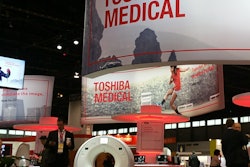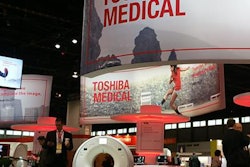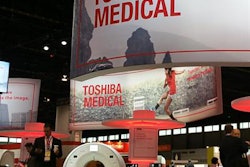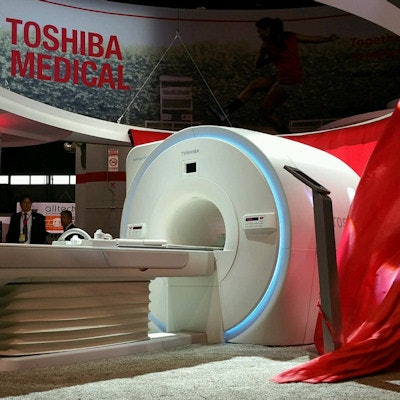
New product launches in MRI and CT are among the highlights in the RSNA 2016 booth of Toshiba America Medical Systems. The company is also launching a double-sliding interventional C-arm and featuring new enhancements in ultrasound.
MRI
Vantage Galan 3T is a new 3-tesla MRI scanner designed to offer high-quality images with a new level of patient comfort, according to the company. It includes new versions of Toshiba technologies that reduce noise during MRI scans while improving image quality.
Galan 3T features the newest version of Pianissimo, Toshiba's MRI noise reduction technology. Called Pianissimo Zen, the technology reduced MRI scanning noise by 99.8%; in trials of the system, scanning noises could not be heard outside the scanner control room, according to the company.
 Toshiba pulled the wraps off its new Vantage Galan 3-tesla MRI scanner at RSNA 2016.
Toshiba pulled the wraps off its new Vantage Galan 3-tesla MRI scanner at RSNA 2016.The scanner has a 71-cm magnet bore, with Toshiba's PureRF radiofrequency (RF) coils and Saturn gradient technology, which work together to improve signal-to-noise ratio by 20%. In its booth at RSNA 2016, Toshiba is showing a variety of sequences acquired with Galan 3T, including an entire brain workup performed in less than five minutes.
The company is also highlighting the use of its Easy Tech workflow, which makes patient positioning and scanning easier. Meanwhile, MR Theater is a patient entertainment system that helps put patients at ease during scanning.
Galan 3T has received U.S. Food and Drug Administration (FDA) clearance.
In addition to Galan 3T, Toshiba is demonstrating improvements to its Vantage Titan scanners. For example, the company earlier in the year received FDA clearance for its Vantage Titan 1.5-tesla cS Edition scanner with M-Power V3.6 software. The new version includes features and applications designed to improve cardiac exams, such as multi-B-value diffusion to measure tissue diffusivity and multiecho T2 mapping to visualize T2 map cartilage images.
CT
In the CT section of Toshiba's booth, the company is introducing Aquilion One Genesis, designed to be a powerful premium scanner that can be sited more easily than comparable high-end scanners.
Genesis includes a range of improvements to provide sharper image resolution and faster exams, all in a package that can be sited in only 204 sq ft. The scanner sports Toshiba's high-end wide detector, with 16 cm of coverage per gantry rotation, and a wide 78-cm aperture.
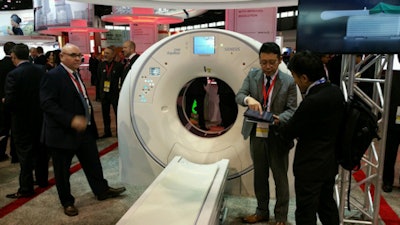 Toshiba's new Aquilion One Genesis CT scanner.
Toshiba's new Aquilion One Genesis CT scanner.Radiation dose has been a major concern in CT scanning, and Toshiba has outfitted Genesis with its new forward-projected model-based iterative reconstruction solution (FIRST), which provides image reconstruction at rates as fast as three minutes per 320-image volume. Because it sets protocols based on the CT scanogram, FIRST enables the use of iterative reconstruction for routine applications without the need to make adjustments for every patient.
Other new enhancements being introduced on Genesis include PureVision Optics and PureVision CT Detector, which improve high-contrast spatial resolution up to 224% in body-scanning mode. Toshiba also bumped up the weight limit on the scanner's table, which can now handle patients weighing up to 694 lb.
With respect to siting the system, Genesis can be located in as few as 204 sq ft (19 sq m) and sports a short bore and flared design, as well as a 30° tilting gantry. By consolidating system electronics, Toshiba created a design that is intended to eliminate the need for the major site construction often required to install a high-end scanner.
Genesis is already installed at the U.S. National Institutes of Health in Bethesda, MD, and the system has FDA clearance.
Ultrasound
In ultrasound, Toshiba is showing a new i-Series platform for its Aplio line of scanners that includes a new beamformer with 50 cm of depth penetration, compared with penetration in the 40s for the previous Aplio technology.
Currently found on the Aplio i700 and Aplio i800, the i-Series features iPerformance technologies that provide more processing power. It also offers the company's new iBeam technology, which optimizes beam efficiency, increasing penetration and spatial and contrast resolution, while also reducing artifacts and clutter.
Aplio i800 offers advanced clinical applications, as well as a 24-MHz ultrahigh-frequency transducer that provides improved scanning for superficial structures that will expand the range of applications for diagnostic ultrasound, according to the company. Toshiba says both scanners are ideal for shared-services applications with sites with high patient throughput.
Toshiba has also addressed ergonomics with the i-Series with its iSense technology, which provides an image-guided user interface that visually guides clinicians through exams to simplify system operation and improve efficiency. A redesigned touch control screen and a real-time quick scan protocol make automatic image adjustments without requiring users to push buttons, according to the company.
Toshiba pointed out that the Aplio line is scalable, with users able to start with the 700 model and move all the way up to the top-of-the-line 900 system. The i-Series scanners have received FDA clearance and are shipping.
Apart from the Aplio line, Toshiba is launching Xario 200 Platinum, a compact premium version of its Xario 200 scanner that features advanced Toshiba technologies such as precision imaging, differential tissue harmonics (D-THI), and advanced dynamic flow (ADF). Also available is superb microvascular imaging (SMI), for better visualization of low-velocity microvascular blood flow.
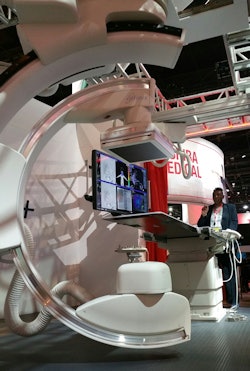 Toshiba is highlighting a new interventional C-arm, Infinix Sky+.
Toshiba is highlighting a new interventional C-arm, Infinix Sky+.The Platinum upgrade is also being rolled out for Xario 100, an entry-level scanner. Xario 100 Platinum also includes precision imaging, D-THI, and ADF, as well as Toshiba's iStyle productivity suite, an adaptable user interface that offers workflow automation tools for faster exams.
Interventional x-ray
Infinix Sky+ is a new offering in Toshiba's vascular x-ray product line that began shipping in the second half of 2016. The system features a novel double-sliding C-arm design that offers 210° of anatomical coverage from any angle, according to the company.
Infinix Sky+ employs 12 x 16-inch flat-panel digital detectors, with high-speed 3D rotation of 80° per second. The C-arm can be placed in a lateral position over or under the table, which enables clinicians to prioritize versatility and safety, such as in sterile operating rooms.
The flat-panel detector can also be positioned above or below patients, offering more flexibility for procedures that require additional space, such as long-needle biopsies, aspirations, and vertebroplasty. Low-contrast imaging can also be performed from the head end or either side of the patient. Finally, Toshiba's Access Halo provides 270° C-arm rotation for easier head-end access.
Also found on Infinix Sky+ are automated radiation dose management tools designed to reduce x-ray exposure, such as Toshiba's Dose Tracking System, which estimates peak skin dose in real-time.
Imaging informatics
Advanced visualization software developer Vital Images is a Toshiba subsidiary, and Toshiba is showing the firm's offerings for both its own scanners and for third-party OEMs. Toshiba is also talking up Vital's recent deal to acquire Karos Health, which offers healthcare informatics interoperability middleware, such as integrating a PACS network with a vendor-neutral archive.





